Why is that the frequency domain has the same shape all through out? Look at figure b

Why is that the frequency domain has the same shape all through out? Look at figure b

It's an effect of the sampling. This mirrors your signal with respect to \$f_S\$/2 and its multiples.
Imagine a spoked wagon wheel you see in a western movie. The wheel has 12 spokes. If the wheel rotates at 2 rotations per second it will go through 1 spoke per frame (two times 12 spokes = 24, and there's 24 frames per second. If the wheel goes through 1/12 of a rotation between two successive images it appears to be standing still: in the second frame the next spoke will have taken exactly the same position as the previous one in the first image. The succession of frames where you freeze the action each time for a split second is important. That's your sampling, and without it you're not going to see the effect of an apparently stationary wheel. If the wheel would rotate twice as fast you'd get the same visual effect, only this time it's the spoke two positions further which has taken the place of the first one.
There's no way you can distinguish between a wheel rotating at 2 rotations per second or 4 rotations per second. Or 6. Or 8. The sampling creates these virtual images which are all equally valid.
Note that this isn't just for when the wheel appears to be standing still. Depending on its actual speed it may appears to rotate (slowly) forward or even backward. Also in these cases there are higher rotation speeds which will create the same visual effect.
The apparently slow rotation is an aliasing effect which you get if the signal's frequency (the spokes' rotation) is higher than half the sampling frequency (the camera's 24 frames per second). In electronic signals this means that the mirror image of your signal will overlap with the original. This is to be avoided at all cost, because there's no way to filter this aliased signal out after sampling. Therefore the analog signal should be low-pass filtered before sampling. This filter must be analog, or it would create the same aliasing problem itself. After conversion of the digital signal back to analog you use a similar filter to get rid of the higher frequency images.
Steven is right, but I would add some detail about the theory. I've also written something about this in an answer about FFT.
The short answer is that when computing the spectrum of a signal, we are applying the Fourier transform (or something fancier, but let's stay with that). What happens is that every signal that is discrete in time, will be periodic in frequency, and vice versa.
For the same reason, if you have a perfect sinewave, it will be a single spike in the spectrum.
A consequence of this phenomenon is aliasing: these copies of the spectrum are separated by the sampling frequency (the frequency at which the signal is measured); if it's too low (less than 2*fmax) these copies will merge and you'll lose detail about the original signal. This is the Shannon's theorem.